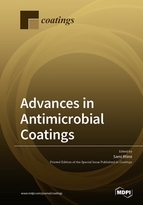Advances in Antimicrobial Coatings
A special issue of Coatings (ISSN 2079-6412).
Deadline for manuscript submissions: closed (31 March 2020) | Viewed by 66356
Special Issue Editor
Interests: catalytic materials; environmental remediation; emergent pollutants; antimicrobials; green new-deal
Special Issues, Collections and Topics in MDPI journals
Special Issue Information
Dear Colleagues,
After the seminal report by T. Matsunaga et al. in 1985, a large number of studies appeared devoted to the issue of microbial abatement in TiO2 suspensions. Many other materials were used to reduce microbes in suspensions thereafter. Due to the cost and labor needed to remove the used materials from the suspension after microbial inactivation, the approach was to fix/support the antibacterial agent on different substrates. During the last decade, the attention was drawn towards the design, synthesis, and characterization of efficient antimicrobial coatings. The latter are of potential use in many industries, such as in medical devices, food packaging, water treatment, ceramics, paints, and many other items in different fields.
We invite authors to contribute original research articles, as well as review articles, that seek to address the mechanisms and significance of antimicrobial coated surfaces for safer environments. A particular interest will be given to papers exploring innovative materials and surfaces engineering.
In particular, the topics of interest include but are not limited to:
- Recent advances in antimicrobial surfaces
- Antimicrobial photocatalytic coatings
- Surfaces engineering for indoor environment
- Antimicrobial coated polymers
- New generation of antimicrobial coated ceramics
- Light enhanced dyes degradation on surfaces
- Water treatment on coated reactors
Dr. Sami Rtimi
Guest Editor
Manuscript Submission Information
Manuscripts should be submitted online at www.mdpi.com by registering and logging in to this website. Once you are registered, click here to go to the submission form. Manuscripts can be submitted until the deadline. All submissions that pass pre-check are peer-reviewed. Accepted papers will be published continuously in the journal (as soon as accepted) and will be listed together on the special issue website. Research articles, review articles as well as short communications are invited. For planned papers, a title and short abstract (about 100 words) can be sent to the Editorial Office for announcement on this website.
Submitted manuscripts should not have been published previously, nor be under consideration for publication elsewhere (except conference proceedings papers). All manuscripts are thoroughly refereed through a single-blind peer-review process. A guide for authors and other relevant information for submission of manuscripts is available on the Instructions for Authors page. Coatings is an international peer-reviewed open access monthly journal published by MDPI.
Please visit the Instructions for Authors page before submitting a manuscript. The Article Processing Charge (APC) for publication in this open access journal is 2600 CHF (Swiss Francs). Submitted papers should be well formatted and use good English. Authors may use MDPI's English editing service prior to publication or during author revisions.
Keywords
- Coatings
- Materials
- Microbial abatement
- Environment
- Characterization






